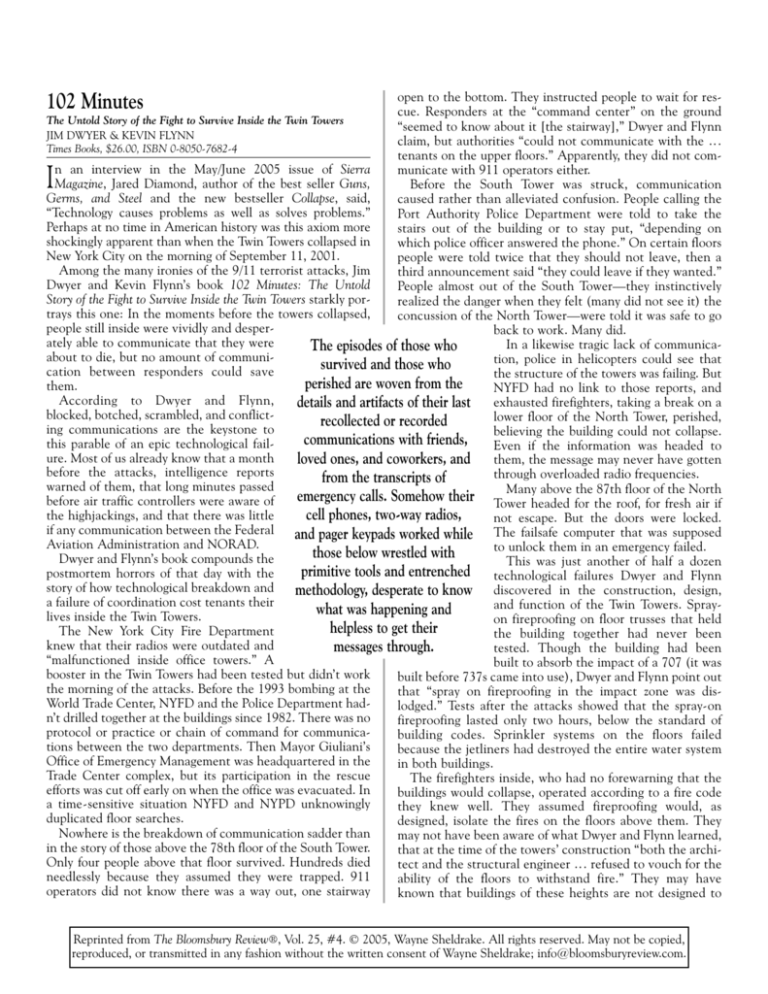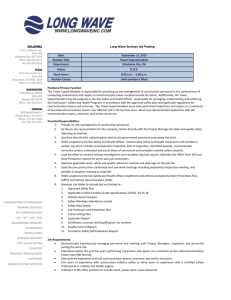
102 Minutes
open to the bottom. They instructed people to wait for rescue. Responders at the “command center” on the ground
The Untold Story of the Fight to Survive Inside the Twin Towers
“seemed to know about it [the stairway],” Dwyer and Flynn
JIM DWYER & KEVIN FLYNN
claim, but authorities “could not communicate with the …
Times Books, $26.00, ISBN 0-8050-7682-4
tenants on the upper floors.” Apparently, they did not comn an interview in the May/June 2005 issue of Sierra
municate with 911 operators either.
Magazine, Jared Diamond, author of the best seller Guns,
Before the South Tower was struck, communication
Germs, and Steel and the new bestseller Collapse, said,
caused rather than alleviated confusion. People calling the
“Technology causes problems as well as solves problems.”
Port Authority Police Department were told to take the
Perhaps at no time in American history was this axiom more
stairs out of the building or to stay put, “depending on
shockingly apparent than when the Twin Towers collapsed in
which police officer answered the phone.” On certain floors
New York City on the morning of September 11, 2001.
people were told twice that they should not leave, then a
Among the many ironies of the 9/11 terrorist attacks, Jim
third announcement said “they could leave if they wanted.”
Dwyer and Kevin Flynn’s book 102 Minutes: The Untold
People almost out of the South Tower—they instinctively
Story of the Fight to Survive Inside the Twin Towers starkly porrealized the danger when they felt (many did not see it) the
trays this one: In the moments before the towers collapsed,
concussion of the North Tower—were told it was safe to go
people still inside were vividly and desperback to work. Many did.
ately able to communicate that they were
In a likewise tragic lack of communicaThe episodes of those who
about to die, but no amount of communition,
police in helicopters could see that
survived and those who
cation between responders could save
the structure of the towers was failing. But
perished are woven from the
them.
NYFD had no link to those reports, and
According to Dwyer and Flynn,
details and artifacts of their last exhausted firefighters, taking a break on a
blocked, botched, scrambled, and conflictlower floor of the North Tower, perished,
recollected or recorded
ing communications are the keystone to
believing the building could not collapse.
communications with friends,
this parable of an epic technological failEven if the information was headed to
ure. Most of us already know that a month
loved ones, and coworkers, and them, the message may never have gotten
before the attacks, intelligence reports
through overloaded radio frequencies.
from the transcripts of
warned of them, that long minutes passed
Many above the 87th floor of the North
emergency calls. Somehow their Tower headed for the roof, for fresh air if
before air traffic controllers were aware of
the highjackings, and that there was little
cell phones, two-way radios,
not escape. But the doors were locked.
if any communication between the Federal
and pager keypads worked while The failsafe computer that was supposed
Aviation Administration and NORAD.
to unlock them in an emergency failed.
those below wrestled with
Dwyer and Flynn’s book compounds the
This was just another of half a dozen
primitive tools and entrenched technological failures Dwyer and Flynn
postmortem horrors of that day with the
story of how technological breakdown and
methodology, desperate to know discovered in the construction, design,
a failure of coordination cost tenants their
and function of the Twin Towers. Spraywhat was happening and
lives inside the Twin Towers.
on fireproofing on floor trusses that held
helpless to get their
The New York City Fire Department
the building together had never been
knew that their radios were outdated and
messages through.
tested. Though the building had been
“malfunctioned inside office towers.” A
built to absorb the impact of a 707 (it was
booster in the Twin Towers had been tested but didn’t work
built before 737s came into use), Dwyer and Flynn point out
the morning of the attacks. Before the 1993 bombing at the
that “spray on fireproofing in the impact zone was disWorld Trade Center, NYFD and the Police Department hadlodged.” Tests after the attacks showed that the spray-on
n’t drilled together at the buildings since 1982. There was no
fireproofing lasted only two hours, below the standard of
protocol or practice or chain of command for communicabuilding codes. Sprinkler systems on the floors failed
tions between the two departments. Then Mayor Giuliani’s
because the jetliners had destroyed the entire water system
Office of Emergency Management was headquartered in the
in both buildings.
Trade Center complex, but its participation in the rescue
The firefighters inside, who had no forewarning that the
efforts was cut off early on when the office was evacuated. In
buildings would collapse, operated according to a fire code
a time-sensitive situation NYFD and NYPD unknowingly
they knew well. They assumed fireproofing would, as
duplicated floor searches.
designed, isolate the fires on the floors above them. They
Nowhere is the breakdown of communication sadder than
may not have been aware of what Dwyer and Flynn learned,
in the story of those above the 78th floor of the South Tower.
that at the time of the towers’ construction “both the archiOnly four people above that floor survived. Hundreds died
tect and the structural engineer … refused to vouch for the
needlessly because they assumed they were trapped. 911
ability of the floors to withstand fire.” They may have
operators did not know there was a way out, one stairway
known that buildings of these heights are not designed to
I
Reprinted from The Bloomsbury Review®, Vol. 25, #4. © 2005, Wayne Sheldrake. All rights reserved. May not be copied,
reproduced, or transmitted in any fashion without the written consent of Wayne Sheldrake; info@bloomsburyreview.com.
evacuate everyone at once, and that to maximize commercial space, each tower was built with only three stairways,
whereas the Empire State Building, built in 1931, has nine.
Despite the maddeningly obvious failure of technology
and communication on that brutal September morning, this
book is not an exposé of failed rescue efforts. It is a work
toward the truth of a Titanic-like catastrophe layered in
technological hubris and human mishap. Conditions for disaster were present long before the impact of the attacking
jetliners. Titanic-like? Yes. Almost everyone in the towers
who was also there for the 1993 terrorist bombing believed
the towers to be indestructible. (It has been reported that
Bin Laden himself was startled when the buildings came
down.)
Dwyer and Flynn tell the story with a smart journalistic
eye for detail, balance, and structure. The book is frenzied in
pace mostly because of the reader’s inevitable perspective.
Every moment drips with dramatic irony. As we follow the
thousands of individual decisions made inside the building,
decisions with partial or inaccurate information, we all know
those towers will fall. To their credit, Dwyer and Flynn
respectfully avoid sensationalism, graphic or macabre
description of suffering of ordinary people in an inordinately
volatile setting.
With a cinematic feel for the turns of the action, their narrative rides on the dialogue and movement of dozens and
dozens of survivors, victims, and responders. Indeed, the
core of the story is restricted to the cage the towers became
for those struggling inside. The episodes of those who survived and those who perished are woven from the details
and artifacts of their last recollected or recorded communications with friends, loved ones, and coworkers, and from
the transcripts of emergency calls. Somehow their cell
phones, two-way radios, and pager keypads worked while
those below wrestled with primitive tools and entrenched
methodology, desperate to know what was happening and
helpless to get their messages through.
Much like William Langewiesche’s American Ground,
which describes the technological and engineering feat of
deconstructing the collapsed Twin Towers, Dwyer and Flynn
celebrate the genius of human improvisation, individual
intelligence, and grit in the moment. Langewiesche also
made clear that such genius is necessary when bureaucracies, communications, and political red tape fail to grasp the
situational awareness a crisis demands. It is unfortunate that
102 Minutes, rendered so humanely, and which should be
hailed as a poignant, objective homage to survivors and victims, may be better remembered as a rebuking technological
eulogy.
REVIEWER: Wayne K. Sheldrake earned his MFA in creative nonfiction from Antioch University/Los Angeles. He
teaches writing at Adams State College in Alamosa, CO,
and writes regularly for America West magazine.
Reprinted from The Bloomsbury Review®, Vol. 25, #. © 2005, Wayne Sheldrake. All rights reserved. May not be copied,
reproduced, or transmitted in any fashion without the written consent of Wayne Sheldrake; info@bloomsburyreview.com.








